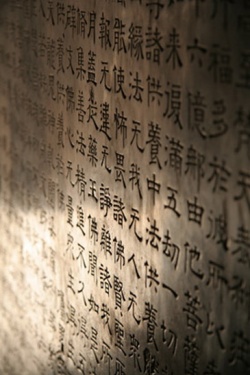Guide to Mahayana Sutras
Jump to navigation
Jump to search
Other Names
|
Notes
| |
| Shorter Amitabha Sutra. |
One of the three sutras that form the doctrinal basis of the Pureland School - the two others are Meditation Sutra and Longer Amitabha Sutra. It describes the Blessings and Virtues of Amitabha Buddha and his Pureland, and discusses rebirth. | |
| Flower Ornament Sutra. Flower Garland Sutra. |
Second longest sutra in the Mahayana Canon, (40 chapters). It consists of large important, independent sutras, namely: Gandavyuha Sutra, Dashabhumika Sutra, Amitayurdyhana Sutra. It records the higher teaching of the Buddha to Bodhisattvas and other high spiritual beings. | |
Brahma Net
|
Brahmajala Sutra. | This contains the Ten Major Precepts of Mahayana followers, and the Bodhisattva Precepts. |
| Vajracchedika Prajnaparamita Sutra. | One of the two most famous scriptures in the Prajnaparamita group of sutras (the other is the Heart Sutra). The Diamond Sutra sets forth the doctrines of Sunyata (emptiness) and Prajna (wisdom). | |
| Prajnaparamita-Hrdaya Sutra. | One of the smallest sutras, and with the Diamond Sutra, one of the most popular of the 40 sutras, in the vast Prajnaparamita literature. Its emphasis is on emptiness. | |
Heroic Gate
|
Surangama Sutra. | Emphasises the power of Samadhi (meditation) and explains various methods of emptiness meditation. A key text of the Ch'an and Zen traditions. |
Jewel Heap
|
Ratnakuta Sutra. | One of the oldest sutras, which belongs to the Vaipulya group of 49 independent sutras. Summary: The philosophy of the middle is developed, which later becomes the basis for the Madhyamaka teaching of Nagarjuna. It contains sutras on transcendental wisdom (Prajnaparamita Sutra) and the Longer Amitabha Sutra. |
| A scriptural basis of the Yogacara and Zen Schools. It teaches subjective idealism based on the Buddha's enlightenment, and doctrines of emptiness and mind only. | ||
Longer Amitabha
|
Larger Amitabha Sutra. |
One of the three core Pueland texts. It explains cause and effect, and describes the Pureland. |
| Saddharma Pundarika Sutra. Lotus of the Good Law. |
A major text, of which the Tendai (T'ien T'ai) use as a main scripture. It teaches the identification of the historical Buddha, with the Transcendental Buddha. | |
| Amitayurdyhana Sutra. | One of the three core texts of the Pureland school. It teaches meditation and visualisation. | |
| Dasabhumika Sutra. Sutra on the Ten Stages. |
This sutra is the 26th chapter of Avatamsaka Sutra, and is also an independent sutra. It establishes the ten stages of cultivation that the Bodhisattva must traverse on the path to enlightenment. | |
| This is a philosophic dramatic discourse, in which basic Mahayana principles are presented in the form of a conversation between famous Buddhist figures, and the householder, Vimalakirti. |
